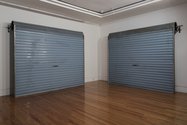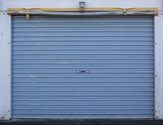John Hurrell – 31 December, 2012
In the gallery by themselves Thompson's three rolled down doors look oddly elegant held up on brackets, even formal as if minimalist sculpture, despite the fact we can detect fraught attempts by Emery to remove the paint lines, and the presence of accumulated grime on the upper portions. Not surprisingly this story generates a wide range of heated individual responses, with only a few agreeing with the judicial outcome as a desirable result.
Auckland
Luke Willis Thompson
Untitled, 2012
17 November 2012 - 10 February 2013
In Te Tuhi’s Bev Smail Gallery Luke Willis Thompson - as part of Between Memory and Trace - presents the three roller doors originally owned by Manurewa businessman Bruce Emery and which on the morning of 26 January 2006, were tagged by Pihema Cameron and a friend. The two teenagers were spotted by Emery, pursued on foot and Cameron tragically killed with a fishing knife.
In the reading room next door Thompson has left a folder with a collection of pertinent (mostly) online articles, including an eleven page judge’s statement read to the accused before sentencing. Emery was found guilty of manslaughter (not murder) sentenced to 4 years and 3 months, but serving 11 months in prison before serving another year in home detention.
Some artists (like say, Ronald Jones or Thomas Demand), as part of their practice, create replicas of objects or sites connected to notorious incidents or crimes, while others (like Ann Shelton) or Luke Willis Thompson here, incorporate the original location (perhaps via its documentary image) or item in their exhibitions. In the gallery by themselves Thompson’s three rolled down doors look oddly elegant held up on brackets, even formal as if minimalist sculpture, despite the fact we can detect fraught attempts by Emery to remove the paint lines, and the presence of accumulated grime on the upper portions.
Not surprisingly this story generates a wide range of heated individual responses, with only a few agreeing with the judicial outcome as a desirable result. The three blue-grey ‘readymades’ on display end up metaphorically pointing at the dramatic sequence of events and their accompanying clusters of social issues. But is that enough to make it interesting art? Just those doors?
What is ‘interesting’ and what does it take to be such? This show is certainly engrossing. The contextual folder of course is the key. The questions seem to be open with no conclusive moral assessment arrived at - according to the visual evidence on display, including the dossier.
Yet many people (myself included) will read the judge’s summation and be appalled by some of his assumptions. I personally was disturbed by his implication that a self-employed, family-based, church going person was better for the community than one who wasn’t, and also by his lumping together of tagging, graffiti, street art and ‘wilful damage’ under the waffly bracket of ‘some regard it’. This avoids certain key issues. What was the nature of the victim’s intentions? Why did the two boys choose Emery’s garages? Was their decision spontaneous or planned? Were their marks gang related?
Such searching questions seem to me important to grasping the nature of their stupidity - not to justify the irresponsibility of Emery’s terrible reaction but to grasp the psychological context and the nature of their irresponsibility as a means of approaching resolution - just as the difference between spontaneity and premeditation decided (apparently) in Emery’s action what is manslaughter and what is murder.
As for the three tightly scrolled doors, the outer two flank the central one in perfect alignment, but with the top of each rolled cylinder curving over so that its plane descends as a vertical sheet to the polished wooden floor. Their formal perfection is artificial (as if symbols for the three protagonists of the story), their placement a fictitious new ‘installed’ alignment of wall planes, at right angles to each other with no motors or entrance ways, no dangling looped chains or control buttons. Like any Bunnings-type product display, it’s sweetly effective through its elegant simplicity blended with rawness. Oddly brutal, functional and industrial, Thompson’s display is visually impressive - if you don’t know the story… and even more so if you do. A catalyst for prolonged conversation and soul searching.
John Hurrell






 Advertising in this column
Advertising in this column Two Rooms presents a program of residencies and projects
Two Rooms presents a program of residencies and projects



This Discussion has 0 comments.
Comment
Participate
Register to Participate.
Sign in
Sign in to an existing account.